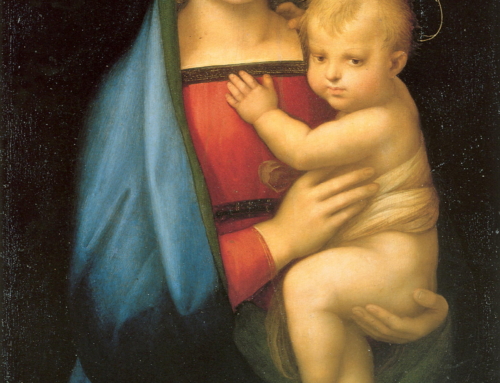Will the atheist cynics and Protestant scoffers never cease with the old canard that Catholicism is simply old paganism in a new dress? These critics notice similarities between certain Roman Catholic customs and the old Roman religion and snipe that our faith is no more than paganism with a face lift.
“Christmas!” they cry, “your so-called celebration of the birth of Christ is no more than the old pagan Roman midwinter Saturnalia, and your Christmas trees are merely a carry over from ancient Germanic fertility rites.”
It is true. The Romans had a mid winter celebration called Saturnalia. From December 17-23 they partied with feasting and foolishness. It was a week of food, frivolity, high table and hi-jinks. Then, so the cynical story goes, when the Emperor and his mother converted to the Christian faith, the new spoil sport religion frowned on such decadence, but the people still wanted to party. So the pope came up with a great idea. “I know! Let’s have Christmas instead!”
Could the theory be true? On first glance it sounds plausible enough, but like the solution to a murder mystery–the obvious answer is rarely the right one. The first objection to is the simple fact that the early Christians were adamantly opposed to paganism in all its forms.
They had inherited from the Jewish first Christians the conviction that the pagan gods and goddesses were demons, and if you worshipped them you were demon possessed. That’s why the catechesis for converts took so long and involved so many careful exorcisms. That’s why the early Christians would not offer so much as one grain of incense to the pagan gods. That’s why, rather than do so, they were willing to be deprived of their property, exiled, imprisoned, tortured and killed. So we’re supposed to believe that in the early fourth century the Christians did a complete about face and said, “Well, I guess we were wrong about paganism. Gee, what a waste all those martyrdoms were. You know, it’s going to be real popular to adopt that Saturnalia festival, and we’re going to get lots of new converts that way. Let’s do it!” I doubt it.
The second objection to such seemingly sensible theories is that the theorists fall into the error of believing that similarities demand causation. That is to say that if two things are similar one must have influenced the other. Similarities might involve causation, but they do not demand causation. Primitive people may have worshipped the sun in Mexico and the Middle East, in Egypt and Asia, in Norway and New Zealand, but it doesn’t mean that all the ancient religions influenced each other. It might just be that human beings everywhere have a natural inclination to worship the sun. Just because the Romans had a mid winter festival honoring Saturn does not demand that the Christians copied it–even if the similarities suggest it.
When trying to solve the mystery of the relationship between Christmas and the Saturnalia we have to consider not only the similarities, but the differences. The Saturnalia was celebrated from December 17 – 23. Okay that’s pretty close to the December 25 date for Christmas–but if they were copying the Saturnalia, why didn’t the early Christians celebrate the Nativity of Christ on December 17? At the Saturnalia they had a feast. Good. Christians had a feast too. The Romans gave each other gifts as part of the celebration. There’s a match. Christians did too. However, the Romans also wore silly hats, got drunk, danced naked in the streets, propped up the statue of Saturn on a couch to observe the revelries, reversed roles between slaves and masters, and put green drapes around their doorways. None of those fun activities are part of Christmas.
The most glaring difference is in the meaning of the celebration itself. If there were some sort of link with the birth of Christ you would expect that the meaning of the Saturnalia might have something to do with the coming of light in the dark time of the year or the birth of new life in the midst of the cold and dark. The Saturnalia has none of those themes. Instead, Saturn was the god of agricultural plenty, with the shadow side, (in the earlier myths) of being associated with human sacrifice. It’s roots are in the old, “Let’s sacrifice some of our kids to appease the god so he’ll make our crops grow” type of paganism. Nothing there about the light dawning in the darkness or the blessing of new life in the midst of the bleak mid winter. So in fact, about the only things that are similar between Christmas and the Saturnalia are that they both happened in December, people had a nice meal and gave gifts to each other.
The Saturnalia may not have had any meaningful link with Christmas, but there was a pagan festival for the solstice which did celebrate the coming of the light and victory over darkness, and it was celebrated on December 25. Instead of a link between Christmas and the Saturnalia scholars suggest that the date of Christmas was a Christian takeover of the feast of Dies Natalis Sol Invictus–the birthday of the Roman sun god Sol.
The problem is– this Roman feast is a late innovation. In the year 278AD (well after Christianity began to burgeon across the empire) the Emporer Aurelian began to promote the cult of Sol Invictus. There is no evidence that the birth of Sol Invictus was celebrated on December 25 until around 360 AD. This is well after the date of Emperor Constantine’s conversion in 315, and during the influence of Julian the Apostate–who attempted to turn back the tide of Christianity and return Rome to its pagan origins. Therefore instead of Christians adopting a pagan holiday and making it their own it’s probably exactly the reverse: the pagans–being threatened by Christianity–copied the Christian celebration. The celebration of the Nativity of Sol Invictus was a late pagan attempt to compete with the celebration of the Nativity of Christ the Lord–the Dayspring from on High and the Sun of Righteousness– on December 25.
So where did the date of Christmas originate? In 386 St John Chrysostom preached a sermon linking the date for Christmas to the date of the Annunciation. He does so in a way that suggests that this was already an established belief. The date of the Annunciation was based on a Jewish tradition that the world was created on March 25. The Jews also believed that a great man would die on the same day as his conception. The date for Jesus Christ’s death was Nisan 15 according to the Jewish calendar, or March 25 according to the Roman calendar. The early Christians (who were of course Jews) concluded that Jesus was therefore conceived on March 25. Thus the day of the world’s creation, and the day of the world’s redemption (and therefore the beginning of the new creation) was March 25.
It’s easy. If the Lord Jesus Christ was conceived on March 25, then he was born nine months later on December 25. The date for Christmas is therefore determined by the date of the Annunciation and has nothing to do with the Roman celebration of the Saturnalia or the celebration of the birthday of Sol Invictus.
So Christmas Day cannot be separated from Ladyday–the medieval term for the Feast of the Annunciation. Furthermore, as we now celebrate New Years’ Day just one week from Christmas, (and so celebrate in the Christ child’s birth a new beginning) in the Middle Ages it was not so. From the apostolic age through the Middle Ages, the church continued to battle with the vestiges of paganism (rather than adopting pagan customs) The celebration of the New Year on the first of January was considered a pagan festival, so until 1752 the new year was celebrated in Europe not at the beginning of January but on the Christian date of March 25.
This fact alone gives the lie to the idea that early Christians adopted pagan festivals for their own. Until the eighteenth century they deliberately avoided the pagan new year and celebrated on March 25 instead. So if any mid winter festival is pagan it’s New Year’s Eve –which isn’t on the Christian calendar at all.
What about Frodo Baggins? Tolkien fans the world over celebrate March 25 as a day of celebration by the reading of Tolkien’s work. Why is that? Because the day Frodo Baggins saves the world by delivering the ring into the fires of Mount Doom was (you guessed it) March 25. Ladyday–the feast of the Annunciation and the traditional date for the beginning of the world’s redemption.







[…] Christmas, Pagan Romans and Frodo Baggins – What is the true date for the birth of Jesus and what does it have to do with Frodo? […]